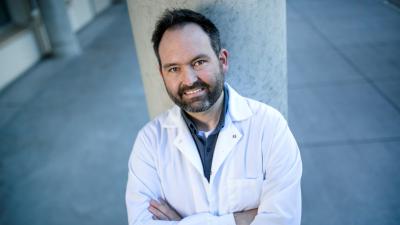
The Biology of Brain Tumors
Enhancing Understanding and Treatment of Brain Tumors through Advanced Research
Brain tumors pose significant challenges in the field of medical science, and gaining a better understanding of their biology is crucial for developing more targeted treatments and, potentially, finding a cure for brain cancer.
Dr. Zach Reitman, an esteemed medical professional with expertise in both medicine and research, along with his colleagues, is engaged in groundbreaking work striving to provide significant biological insights into various types of brain tumors. Their efforts have the potential to improve care for both adults and children while aiding doctors in matching patients with the most effective therapies.
Enhancing Radiation Therapy for Diffuse Midline Gliomas in Children
One particular project undertaken by Dr. Reitman and his team focuses on finding ways to enhance the efficacy of radiation therapy for diffuse midline gliomas, a deadly type of pediatric brain tumor. Currently, radiation therapy is the only known treatment option for this condition. However, despite treatment, cancer invariably progresses, and patients die within a year of diagnosis.
By utilizing mouse models, Dr, Reitman and his team aim to identify the genetic subtypes of tumors that respond best to radiation therapy when combined with other drugs that increase the vulnerability of cancer cells to radiation. One such drug being explored is a novel treatment that targets ATM (ataxia telangiectasia mutated) Kinase.
“It’s an exciting opportunity because the drug is already being tested in another type of brain tumor,” says Reitman, a medical instructor in the Department of Radiation Oncology. “If we can add to that with our mouse modeling work, we might be able to build a scientific rationale to open clinical trials of this drug in children with this devastating disease and perhaps make an important advance.”
Identifying Effective Treatments For Glioblastomas
In another project, the Reitman lab, in collaboration with other experts at the Preston Robert Tisch Brain Tumor Center, including Dr. Hai Yan, seeks to identify drugs that can effectively treat the majority of glioblastomas. A critical discovery made by this collaborative effort revealed that approximately 80 percent of adult glioblastomas contain a mutation affecting the telomerase reverse transcriptase (TERT) gene.
Unfortunately, to date, no effective targeting of this mutation has benefited glioblastoma patients. Dr. Reitman and his team are determined to change that. They have developed cell lines that will allow them to conduct genetic and chemical screens to find vulnerabilities associated with the TERT mutations. The idea is to find a way to repurpose existing drugs to target the mutations.
“The screens that we’re doing will look at whether knocking out any of 18,000 genes in the genome might lead to a specific vulnerability in TERT mutant brain tumors, which has never been done in this way before,” he says.
Advancing Diagnostic and Treatment Approaches through Single Cell Genomics
The third project undertaken by Dr. Reitman's team focuses on understanding the composition of brain tumors at a single-cell level. This line of research has the potential to revolutionize the diagnosis, monitoring, and treatment of brain tumor patients.
Prior to joining Duke, Dr. Reitman and his colleagues conducted a study using single-cell RNA sequencing to examine the transcriptional landscape of a pediatric brain tumor known as pilocytic astrocytoma. They also utilized this technique to investigate the effects of drugs on brain tumors, yielding significant findings related to the MAP kinase pathway.
“A big mystery has been that the responses to these MAPK-directed drug therapies were very different from patient to patient,” Reitman says. “Our study provided a potential explanation: that only a subset of the tumor cells is highly expressing the MAP kinase pathway.”
In August 2019, the Tisch Brain Tumor Center recruited Reitman to Duke to use single-cell genomics techniques to study brain tumors. “Our long-term goal is that this would allow us to develop tests in the clinic that would allow us to select the right drugs for the right patients.”
Glioma vs Glioblastoma
Glioma and glioblastoma are two terms often used when discussing brain tumors, but they have distinct features that impact their diagnosis, risk factors, and treatment approaches. Here is a brief break down of the two terms:
- Glioma: A broad term encompassing tumors that originate from glial cells, which are supportive cells found in the brain and spinal cord. Glial cells play crucial roles in providing structural support, maintaining the chemical environment, and nourishing neurons.
- Glioblastoma: This is a type of glioma often referred to as GBM and is known for being one of the most common and aggressive form of glioma.These tumors grow rapidly, infiltrate parts of the brain and surrounding brain tissue, and have a high tendency to recur even after treatments, such as being surgically removed.
Brain Tumor Research & Treatment Center
Dr. Zach Reitman's pioneering work in brain tumor biology offers immense hope for enhancing treatment outcomes and ultimately finding a cure for brain cancer. Through rigorous research focused on optimizing radiation therapy, pinpointing effective treatments for glioblastomas, and pioneering diagnostic methods using single-cell genomics, Dr. Reitman and his team are at the forefront of combatting brain cancer.
If you or someone you know is seeking expertise in brain tumor diagnosis, treatment, or patient care, the Preston Robert Tisch Brain Tumor Center in Durham, NC, stands as one of the premier institutions in the field. Schedule a consultation with our globally recognized medical professionals today.